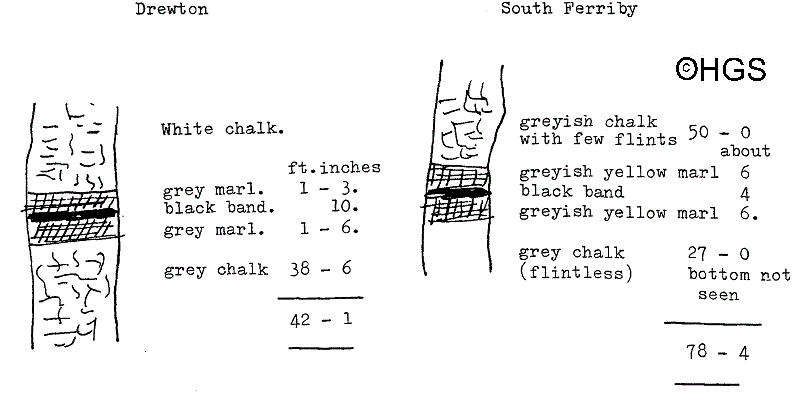

Humberside Geologist no 10
published 1992
On arrival at S. Ferriby the low cliff on the Humber Bank was examined and gave the following results - Lying upon the chalk there was found a band of rough sandstone, showing many ripple marks. Immediately above this sandstone there is a layer of boulder clay varying in thickness. It was of a red colour probably owing to the action of the weather. The greater number of stones contained in it were small & evidently derived from the red chalk and lower strata of the grey chalk. A few larger boulders were found; they were derived from some hard limestone; probably oolitic. Above the boulder clay there is a bed of chalky gravel with a few bands of sand. The gravel is false bedded and has apparently been deposited by currents of water coming from the west. The gravel presents the appearance of a beach formed above the boulder clay at a time when the water stood at a higher level than it does at the present time - showing that since its formation the laud has been elevated.
Chalk pit. - In the small pit the strata of the chalk showed a good deal of displacement - a small fault in one place showing that the chalk in the upper part of the pit had slipped downwards upon a sloping surface of the chalk beneath; just along the fault there is a band of marl which seems to have allowed the chalk above it to slide downwards; probably because of the contained water.
The large pit is excavated in the grey chalk and showed a splendid section of the black band - similar to the band at Drewton found during the construction of the Hull & Barnsley Railway. The section here corresponds almost exactly with that at Drewton both in appearance & thickness.
The following is the measurement of the two sections
FIGURE 1

[N.B. the original spellings and layout have been retained.]
From the above sections it will be seen that the band at Drewton is a little thicker than that south of the Humber. Both sections are probably on the same horizon of the chalk, and are therefore of great value in correlating the strata in the two localities, at Drewton the thickness of the grey chalk measuring from the base of the black band to the top of the red chalk was 38'-6". At the South Ferriby pit only 27' of the grey chalk could be seen below the black band but it is evidently thicker as the Quarry was not dug out deeply enough to show a complete section. After carefully noting the above particulars the party proceeded to examine the chalk as seen in the quarry. The grey chalk was found to contain hardly any flints but above the black band they gradually became more numerous. Many black markings due to crystals of manganese were found. Among the fossils, fragments of Inoceramus were the most common.
In the grey chalk below the black band one ammonite was found.
In the upper part of the pit (above the black band) small of Ptychodus & Oxyrhina ? have been found - but are very scarce. Small echinoderms are fairly numerous in the upper part.
Rhychonellae & Terebratulae are common in all strata.No fossils found in the black band.
The strata of the chalk exposed in this pit are lower down in the chalk series than those seen north of the Humber at Hessle.
The black band dips towards the east - as it also does at Drewton.
The party returned home via Barton passing another large chalk pit which should be examined on another excursion - as it is higher in the chalk series it will probably show strata corresponding with the chalk at Hessle.
The original manuscript of this report is in the archives of the Hull Geological Society. Along with other reports of early field meetings it was copied into a manuscript transactions book which has been lost. There are two versions of this report in the archives both written by F.F. Walton, the first President of the Society.
The thickness of the Lower Chalk from the top of the Red Chalk to the base of the Black Band Member, at South Ferriby now totally exposed in the Quarry is 24 metres (about 76 feet). This is considerably thicker than the 38ft 6 ins that the Society measured at Drewton. This represents a significant thinning of the Lower Chalk north of the Humber towards the Market Weighton High.
It is interesting to see that the Society was taking an interest in the Chalk a hundred years ago and taking measurements of exposures. Since then the South Ferriby pit has been enlarged and the full sequence exposed but the Drewton exposure has been lost. The Society's Chalk Project group tried to find it but the cutting is overgrown with plants and no exposure was found.
This shows the importance of recording measured sections even if they do not seem important at the time. Subsequent developments have allowed us to compare the thickness at the two localities which F F Walton was unable to do and we would be unable to do if it were not for Walton's careful recording. It is important to record and if possible publish such data, even if you are not sure of its significance, someone else may be able to interpret its meaning at a later date!
Mike Horne
copyright Hull Geological Society 2021